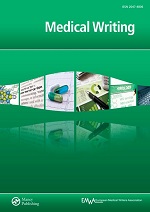
Volume 23, Issue 4 - Post-Approval Regulatory Writing
Post-approval regulatory writing
Author: Lisa Chamberlain James
Abstract

Very often in clinical development, we are focused solely on gaining marketing authorisation for our drugs – the scramble to be first to market, or to bring the next ‘blockbuster’ to patients. Phase I to Phase III is our primary goal. And to a large extent, this is how it should be – there's no point in spending millions on research and development if the drug is never given to patients.
However, what happens afterwards? As medical writers, does our job finish once we've written up the clinical study reports and dossiers, answered the regulatory authorities' questions, and helped a company gain approval? I'd like to think not – I'd argue that medical writers are needed just as much to keep a drug on the market as they are to get it there in the first place.
I'm not immune to the pull of a sexy CTD of course, and I find it almost impossible to refuse when a client calls for help with ‘a new type of…’ or ‘the only treatment for…’. But is the rush to the altar of marketing approval where we should be putting ALL of our focus and energy? Isn't that like putting all of our effort into the birthing of a marketing authorisation and none into keeping the resulting infant drug alive?
Post-approval documentation has always ‘been there’ of course, but was perhaps seen as a necessary evil – a drain on resources with no return on investment. However, in the last few years it has undergone something of a renaissance; driven by the 2012 change in PV legislation and, I believe, the increasing thirst and demand for high quality information from patients, lobbyists, and support groups. The pharmaceutical industry has embraced these changes and is rising admirably to the challenge, but not without teething problems, and this is where the skills of a medical writer can really come to the fore.
This issue of Medical Writing is dedicated to post-authorisation documents and the medical writer's role in them. The first of our feature articles is from Dakshayini Kulkarni and discusses the pharmacovigilance system master file (PSMF). Her article gives a practical guide to handling and improving this constantly evolving document, based on findings from PSMF inspectors.
Sunil Modali explains the differences between and potential difficulties in writing pre- and post-authorisation documents; something that writers more used to pre-authorisation documents may not have considered. Sarah Richardson outlines the role of the strategic medical writer in post-authorisation documents and gives an outline of the legislation. The intricacies of writing non-interventional post-authorisation safety studies are described beautifully by Greg Morely, and finally, Amy Whereat looks at advisory boards specifically, and the issues and potential pitfalls in writing reports for them.
I thank all of the contributors for their willingness to share their knowledge and experience in this area, and for the hard work they have put into their articles. My thanks also to Phillip Leventhal for bravely dedicating a whole issue to this topic and for trusting me with his ‘baby’. Finally – thanks to all of you, for reading this issue. Please do send me your feedback, and let me know if these articles have helped any of your ‘infant drugs’ survive!
 Download the full article
Download the full article
Search
Articles
Links
Editoral Board
Editor-in-Chief
Co-Editors
Managing Editor
Victoria White
Associate Editors
Section Editors
AI/Automation
Biotechnology
Digital Communication
EMWA News
Gained in Translation
Getting Your Foot in the Door
Good Writing Practice
In the Bookstores
Publications
Medical Communications/Writing for Patients
Medical Devices
My First Medical Writing
News from the EMA
Freelancing
Pharmacovigilance
Regulatory Matters
Regulatory Public Disclosure
Teaching Medical Writing
Louisa Ludwig-Begall / Sarah Kabani
The Crofter: Sustainable Communications
Veterinary Writing
Editors Emeritus
Layout Designer
Chris Monk
 Visit the EMWA website
Visit the EMWA website